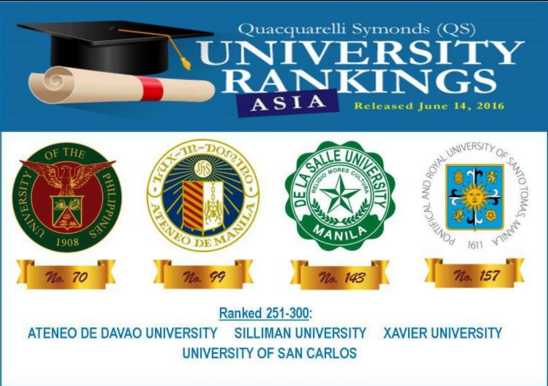MANILA, Philippines – What should Philippine educational institutions do to be included in the list of the world’s top universities?
Mary Sylvette Gunigundo, chief education program specialist of the Commission on Higher Education’s (CHED) Quality Assurance Division, lists at least two ways: promote Philippine universities abroad and analyze the data behind the rankings to be able to find out what indicators should schools focus and improve on.
“We need to have our universities known to other people outside our country, hindi lang ‘yong prino-promote natin ‘yong universities natin dito (and not only promote our universities here in the country),” Gunigundo told InterAksyon on the sidelines of a conference on Internationalization of Higher Education in the ASEAN Region held at the CHED headquarters in Quezon City last Tuesday.
She said Philippine universities could establish international linkages by collaborating with universities and research institutions abroad in faculty and student exchanges, joint research, and other academic activities.
Develop, strengthen niche programs
For the less popular local universities, Gunigundo said additional steps would be needed before collaborating with international institutions. “To be able to link up (with foreign institutions), you should have a good reputation. So you should have an image of high quality (education).”
Gunigundo advised these universities to develop and strengthen their “niche programs” or an area they could specialize in so they could then collaborate with premier local universities first before teaming up with international schools.
“For example, sa tingin ko ‘yong Siliman University, kaya sila na-include (in the 2016 QS Asia University Rankings) even without applying kasi they’re good in Marine Science so ‘yong research nila doon well-cited [For example, I think Siliman University was included in the 2016 QS Asia University Rankings even without applying because they were well-cited on their research on Marine Science],” she said.
Gunigundo said this strategy could also increase the number of graduate programs in local universities that could result in more research outputs and opportunities to conduct joint research with international institutions.
She also suggested to local universities to improve their website to attract more foreign students and employers.
Gunigundo likewise urged them to subscribe to Scopus, the largest abstract and citation database of peer-reviewed literature, because this is where QS collects citation counts of universities and the number of published research papers by its faculty members as among their performance indicators.
‘Analyze scores’
On studying data behind international rankings, Gunigundo said local universities should not just look into the ranking results but also “analyze the scores” and find out in what categories or indicators “we can improve on.”
Academic reputation and employer reputation, which account for 30 percent and 20 percent respectively, are among the 10 performance indicators that the higher education publication Quacquarelli Symonds (QS) assesses in their Asia university rankings, according to Gunigundo.
For Gunigundo, these are the areas or indicators that Philippine universities should initially work on.
“Ang nakikita ko rito ‘yong academic reputation and employer reputation means paano natin siya mai-improve itong perception ng international community [What I see regarding academic reputation and employer reputation is on how we can improve the perception of international community],” she said.
What is the QS World University Rankings?
The QS World University Rankings is an annual publication of UK-based Quacquarelli Symonds designed to give students “informed comparisons of leading universities in the world.”
The publication assesses the ranking of top universities worldwide based on these six performance indicators:
-Academic reputation (40 percent)
-Employer reputation (10 percent)
-Student-to-faculty ratio (20 percent)
-Citations per faculty (20 percent)
-International faculty ratio (5 percent)
-International student ratio (5 percent)
In QS Asia University Rankings, additional indicators and different scoring are observed. These are:
-Academic reputation (30 percent)
-Employer reputation (20 percent)
-Faculty/student ratio (15 percent)
-Citations per paper (10 percent)
-Papers per faculty (10 percent)
-Staff with a PhD (5 percent)
-Proportion of international faculty (2.5 percent)
-Proportion of international students (2.5 percent)
-Proportion of inbound exchange students (2.5 percent)
-Proportion of outbound exchange students (2.5 percent)
In the 2016 QS World University Rankings, the Philippines’ so-called big four higher education institutions – University of the Philippines, Ateneo de Manila University, De La Salle University and University of Santo Tomas – were included in the top 800.
Meanwhile, four more Philippine schools namely Ateneo de Davao, Siliman University, Xavier University, and University of San Carlos figured in the QS Asia University Ranking in the same year.
Gunigundo said more parents are becoming more particular into the rankings of the universities their children are attending.
“In reality, our stakeholders, especially parents, they question schools, especially the big schools, if the schools are not included in the ranking,” she said.







